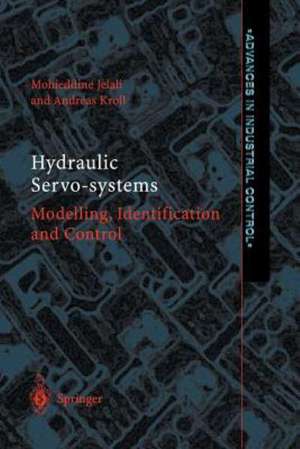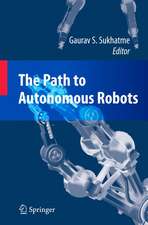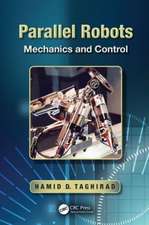Hydraulic Servo-systems: Modelling, Identification and Control: Advances in Industrial Control
Autor Mohieddine Jelali, Andreas Krollen Limba Engleză Paperback – 20 sep 2012
| Toate formatele și edițiile | Preț | Express |
|---|---|---|
| Paperback (1) | 1221.07 lei 6-8 săpt. | |
| SPRINGER LONDON – 20 sep 2012 | 1221.07 lei 6-8 săpt. | |
| Hardback (1) | 1227.67 lei 6-8 săpt. | |
| SPRINGER LONDON – 13 noi 2002 | 1227.67 lei 6-8 săpt. |
Din seria Advances in Industrial Control
- 15%
 Preț: 643.34 lei
Preț: 643.34 lei - 23%
 Preț: 582.63 lei
Preț: 582.63 lei - 18%
 Preț: 783.98 lei
Preț: 783.98 lei - 18%
 Preț: 947.35 lei
Preț: 947.35 lei - 20%
 Preț: 568.24 lei
Preț: 568.24 lei - 15%
 Preț: 643.16 lei
Preț: 643.16 lei - 18%
 Preț: 899.21 lei
Preț: 899.21 lei - 18%
 Preț: 891.33 lei
Preț: 891.33 lei - 18%
 Preț: 740.57 lei
Preț: 740.57 lei - 18%
 Preț: 961.23 lei
Preț: 961.23 lei - 18%
 Preț: 955.08 lei
Preț: 955.08 lei - 15%
 Preț: 645.28 lei
Preț: 645.28 lei - 15%
 Preț: 638.43 lei
Preț: 638.43 lei - 18%
 Preț: 901.11 lei
Preț: 901.11 lei - 18%
 Preț: 1410.94 lei
Preț: 1410.94 lei - 18%
 Preț: 728.91 lei
Preț: 728.91 lei - 20%
 Preț: 1003.78 lei
Preț: 1003.78 lei - 18%
 Preț: 947.35 lei
Preț: 947.35 lei - 15%
 Preț: 643.34 lei
Preț: 643.34 lei - 15%
 Preț: 654.30 lei
Preț: 654.30 lei - 18%
 Preț: 950.52 lei
Preț: 950.52 lei - 15%
 Preț: 644.30 lei
Preț: 644.30 lei - 18%
 Preț: 1393.09 lei
Preț: 1393.09 lei - 18%
 Preț: 950.21 lei
Preț: 950.21 lei - 18%
 Preț: 949.90 lei
Preț: 949.90 lei - 18%
 Preț: 949.42 lei
Preț: 949.42 lei - 18%
 Preț: 950.52 lei
Preț: 950.52 lei - 18%
 Preț: 1113.71 lei
Preț: 1113.71 lei - 15%
 Preț: 650.04 lei
Preț: 650.04 lei - 15%
 Preț: 644.95 lei
Preț: 644.95 lei - 18%
 Preț: 950.33 lei
Preț: 950.33 lei - 18%
 Preț: 948.61 lei
Preț: 948.61 lei - 18%
 Preț: 1112.60 lei
Preț: 1112.60 lei - 15%
 Preț: 644.63 lei
Preț: 644.63 lei - 18%
 Preț: 953.20 lei
Preț: 953.20 lei - 18%
 Preț: 945.62 lei
Preț: 945.62 lei - 15%
 Preț: 640.88 lei
Preț: 640.88 lei - 15%
 Preț: 640.88 lei
Preț: 640.88 lei - 20%
 Preț: 650.92 lei
Preț: 650.92 lei - 18%
 Preț: 1112.60 lei
Preț: 1112.60 lei - 20%
 Preț: 998.36 lei
Preț: 998.36 lei - 15%
 Preț: 643.34 lei
Preț: 643.34 lei - 18%
 Preț: 948.92 lei
Preț: 948.92 lei - 18%
 Preț: 1381.43 lei
Preț: 1381.43 lei - 15%
 Preț: 651.51 lei
Preț: 651.51 lei - 15%
 Preț: 647.08 lei
Preț: 647.08 lei - 20%
 Preț: 563.66 lei
Preț: 563.66 lei - 18%
 Preț: 992.64 lei
Preț: 992.64 lei - 18%
 Preț: 1225.79 lei
Preț: 1225.79 lei
Preț: 1221.07 lei
Preț vechi: 1489.10 lei
-18% Nou
Puncte Express: 1832
Preț estimativ în valută:
233.68€ • 243.07$ • 192.92£
233.68€ • 243.07$ • 192.92£
Carte tipărită la comandă
Livrare economică 14-28 aprilie
Preluare comenzi: 021 569.72.76
Specificații
ISBN-13: 9781447111238
ISBN-10: 1447111230
Pagini: 388
Ilustrații: XXX, 355 p.
Dimensiuni: 155 x 235 x 25 mm
Greutate: 0.54 kg
Ediția:2003
Editura: SPRINGER LONDON
Colecția Springer
Seria Advances in Industrial Control
Locul publicării:London, United Kingdom
ISBN-10: 1447111230
Pagini: 388
Ilustrații: XXX, 355 p.
Dimensiuni: 155 x 235 x 25 mm
Greutate: 0.54 kg
Ediția:2003
Editura: SPRINGER LONDON
Colecția Springer
Seria Advances in Industrial Control
Locul publicării:London, United Kingdom
Public țintă
ResearchCuprins
1 Introduction.- 1.1 Historical View and Motivation for Hydraulic Systems.- 1.2 Aims and Focus of the Book.- 1.3 Outline of the Chapters.- 1.4 Background of the Work and Bibliographical Notes.- 2 General Description of Hydraulic Servo-systems.- 2.1 Basic Structure of Hydraulic Servo-systems.- 2.2 Description of the Components.- 2.3 Classification of Hydraulic Servo-systems.- 2.4 Measurement and Control Devices.- 2.5 Application Examples.- 3 Physical Fundamentals of Hydraulics.- 3.1 Physical Properties of Fluids.- 3.2 General Equations of Fluid Motion.- 3.3 Flow Through Passages.- 3.4 Spool Port Forces.- 3.5 Electro-hydraulic Analogy.- 4 Physically Based Modelling.- 4.1 Introduction.- 4.2 Elementary Models.- 4.3 Typical Non-linear State-space Models.- 4.4 Structured and Simplified Models of Valve-controlled Systems.- 4.5 Determination of Specific Model Parameters.- 4.6 Implementation and Software Tools.- 4.7 Section Summary.- 5 Experimental Modelling (Identification).- 5.1 Introduction.- 5.2 Pre-identification Process.- 5.3 Overview of Model Structures.- 5.4 Description of Selected Non-linear Model Structures.- 5.5 Parameter Estimation Methods.- 5.6 Optimisation Algorithms.- 5.7 Grey-box Identification ofNon-linear Hydraulic Servo-system Models.- 5.8 Fuzzy Identification.- 5.9 Identification with Artificial Neural Networks.- 6 Hydraulic Control Systems Design.- 6.1 Introduction.- 6.2 Classical Feedback Control Design.- 6.3 Estimator-based State Feedback Control.- 6.4 Extensions to Linear Feedback Control.- 6.5 Feedback Linearising Control.- 6.6 Approaches Similar to Feedback Linearisation.- 6.7 Fuzzy Control.- 6.8 Neural-network-based Control.- 6.9 Vibration Damping Control.- 6.10 State Estimation.- 6.11 Implementation and Software Tools.- 6.12 Rapid Prototyping Tools for Control.- 6.13 Section Summary.- 7 Case Studies and Experimental Results.- 7.1 Identification and Control of a Synchronising Cylinder.- 7.2 Modelling and Control of a Small Differential Cylinder.- 7.3 Control of a Big Differential Cylinder.- 7.4 Vibration Damping Control for a Flexible Robot.- 7.5 Vibration Damping Control for a Concrete Pump.- Appendix A Fluid Power Symbols.- Appendix B Data and Catalogue Sheets.- Appendix C Non-linear Control Background.- References.
Recenzii
From the reviews:
Altogether the book gives a comprehensive survey of physical modelling, conventional and modern control stategies for hydraulic drives and can be recommended to engineers and scientists who are working in this field.
Simulation News Europe 38/39 (2003) 61 – 62 (Reviewer: Peter Beater)
Altogether the book gives a comprehensive survey of physical modelling, conventional and modern control stategies for hydraulic drives and can be recommended to engineers and scientists who are working in this field.
Simulation News Europe 38/39 (2003) 61 – 62 (Reviewer: Peter Beater)
Notă biografică
Mohieddine Jelali received the Dipl.-Ing. and Dr.-Ing. degrees from the University of Duisberg, Germany in 1993 and 1997 respectively, both in mechanical engineering. From 1993 to 1996, he was research assistant with the Department of Measurement and Control.
From 1996 to 1999, he worked as a research-and-development engineer with Mannesmann Demag Metallurgy in Ratingen, BU Cold Rolling and Processing. In September 1999, he joined the Betriebsforchungsinstitut - VDEh-Institut für angewandte Forschung GmbH in Düsseldorf as a project manager and co-ordinator of multinational research projects in the steel industry. His main fields of interest include: modelling, dynamic simulation, development of advanced controls and control prototyping for rolling mills and supervisory control of steel processes.
Since October he has been a lecturer in control systems at the University of Duisberg. He has written/co-written 14 research publications.
Andreas Kroll obtained his Dr.-Ing. in mechanical engineering at the University of Duisberg in 1996. From 1993 to 1996, he was also a research assistant with the Department of Measurement and Control.
In 1996 Doctor Kroll joined the ABB Research Centre in Heidelberg as a research-and-development engineer. Since 1998, he has been International R&D manager and since 2000, the group leader for Applied Control and Optimisation. His current research interests include: methods of computational intelligence, advanced process control and applications, dynamic simulation and optimisation of processes, international project management and personal and technological strategies of the line unit.
He has written or co-written 16 publications.
From 1996 to 1999, he worked as a research-and-development engineer with Mannesmann Demag Metallurgy in Ratingen, BU Cold Rolling and Processing. In September 1999, he joined the Betriebsforchungsinstitut - VDEh-Institut für angewandte Forschung GmbH in Düsseldorf as a project manager and co-ordinator of multinational research projects in the steel industry. His main fields of interest include: modelling, dynamic simulation, development of advanced controls and control prototyping for rolling mills and supervisory control of steel processes.
Since October he has been a lecturer in control systems at the University of Duisberg. He has written/co-written 14 research publications.
Andreas Kroll obtained his Dr.-Ing. in mechanical engineering at the University of Duisberg in 1996. From 1993 to 1996, he was also a research assistant with the Department of Measurement and Control.
In 1996 Doctor Kroll joined the ABB Research Centre in Heidelberg as a research-and-development engineer. Since 1998, he has been International R&D manager and since 2000, the group leader for Applied Control and Optimisation. His current research interests include: methods of computational intelligence, advanced process control and applications, dynamic simulation and optimisation of processes, international project management and personal and technological strategies of the line unit.
He has written or co-written 16 publications.
Textul de pe ultima copertă
Hydraulic Servo-systems details the basic concepts of many recent developments of nonlinear identification and nonlinear control and their application to hydraulic servo-systems: developments such as feedback linearisation and fuzzy control. The principles, benefits and limitations associated with standard control design approaches such as linear state feedback control, feedforward control and compensation for static nonlinearities are also reviewed, because of their continued practical importance.
Featuring:
• theoretical (physically based) modelling of hydraulic servo-systems;
• experimental modelling (system identification);
• control strategies for hydraulic servo-systems;
• case studies and experimental results.
Appendices outline the most important fundamentals of (nonlinear) differential geometry and fuzzy control. The book is very application-oriented and provides the reader with detailed working procedures and hints for implementation routines and software tools.
Hydraulic Servo-systems will interest scientists and qualified engineers involved in the analysis and design of hydraulic control systems, especially in advanced hydraulic industries, the aeronautical and space, and automotive industries.
Advances in Industrial Control aims to report and encourage the transfer of technology in control engineering. The rapid development of control technology has an impact on all areas of the control discipline. The series offers an opportunity for researchers to present an extended exposition of new work in all aspects of industrial control.
Featuring:
• theoretical (physically based) modelling of hydraulic servo-systems;
• experimental modelling (system identification);
• control strategies for hydraulic servo-systems;
• case studies and experimental results.
Appendices outline the most important fundamentals of (nonlinear) differential geometry and fuzzy control. The book is very application-oriented and provides the reader with detailed working procedures and hints for implementation routines and software tools.
Hydraulic Servo-systems will interest scientists and qualified engineers involved in the analysis and design of hydraulic control systems, especially in advanced hydraulic industries, the aeronautical and space, and automotive industries.
Advances in Industrial Control aims to report and encourage the transfer of technology in control engineering. The rapid development of control technology has an impact on all areas of the control discipline. The series offers an opportunity for researchers to present an extended exposition of new work in all aspects of industrial control.
Caracteristici
The reader will gain up-to-date knowledge in the area of servo-system control and of hydraulic servo-systems in particular The detailed working procedures and advice on implementation routines and software tools will make it easier for the reader to apply the control models and systems presented so as to make his own systems more efficient Keeps mathematical complexity to a minimum Includes supplementary material: sn.pub/extras



















